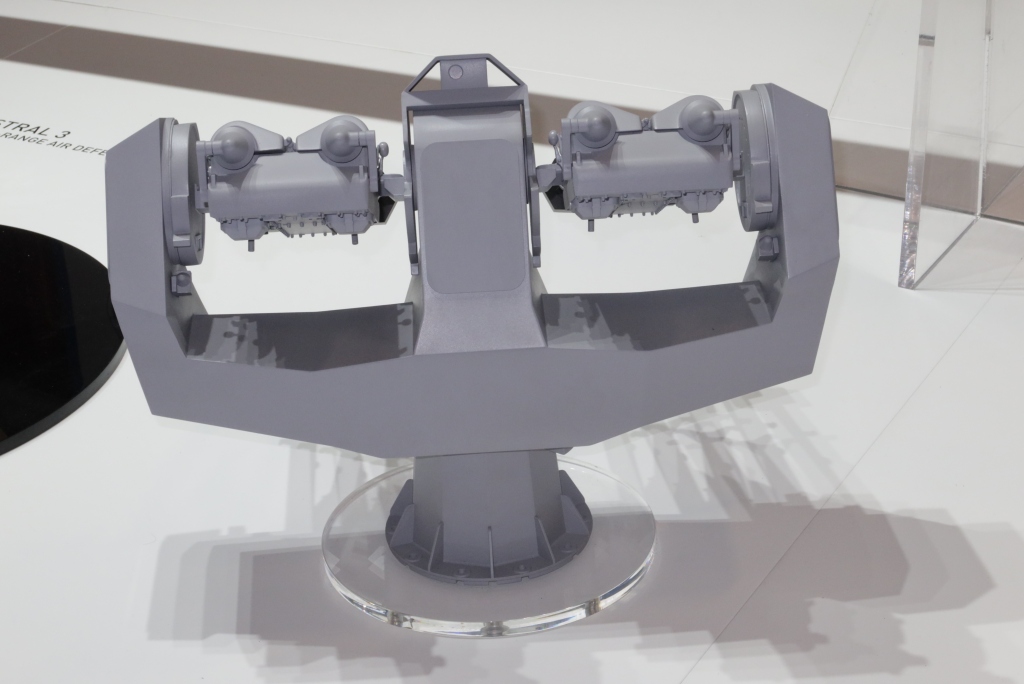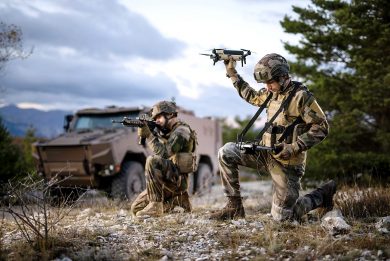
Euronaval 2024 – MBDA unveils new SIMBAD-RC 2 and 4

The recent naval operations in the Red Sea and the growing threat caused by low cost weapon systems such as aerial drones and kamikaze unmanned surface vehicles have pushed MBDA to further evolve its SIMBAD-RC remotely controlled self-defence system, presenting its latest “all-French made” two-missile (RC 2) or new four-missile (RC 4) versions equipped with software-enhanced Mistral 3 weapon system, to be ready for deliveries respectively in early 2026 and 2027.
Developed as the main air defence for fast patrol boat, auxiliary and amphibious ships as well as the complementary air defence system for first-line combatant platforms, the SIMBAD-RC is a lightweight, remotely controlled, close-in defence system which uses latest Mistral 3 passive fire-and-forget IIR-guided surface-to-air missile version against a range of conventional and asymmetric threats, from fixed-to-rotary wing manned platforms to sea-skimming and manoeuvring anti-ship missiles or small-size low infrared signature threats such as UAVs, as well as small surface unmanned platforms such as kamikaze RHIBs, up to a range of 8 km.

The current baseline SIMBAD-RC architecture can control up two lightweight, gyro-stabilised turrets equipped with a launching pod for two lock-on before launch (LOBL) Mistral missiles canisters each equipped with openable front cap for missile homing system acquisition and tracking and a Safran Electronics & Defense MATIS SP dual field-of-view mid-wave band cooled thermal camera, all managed by a dedicated compact terminal known as SMU-RC and interfaced with the ship’s combat system or surveillance sensors, in addition to a stand-alone user mode.

MBDA has developed a new all ITAR-free version, most of the supply chain being national, with a new turret provided by Cegelec Défense which, contrary to the current model, incorporates all the components necessary to operate including the power supply unit, which is a separate module in the current configuration, and featuring a new design with a common pedestal capable to accommodate respectively a single two-missile pod (RC2) or two pods (RC4). The latter has been developed to counter saturation attacks, having twice the number of ready-to-fire missiles, a single system providing the same fire power of the current two-turret configuration, or double the latter fire power. On the new single pod turret version the MATIS SP thermal camera is installed on top of the right arm, while on the twin pod version it is positioned on the central arm. With the same bearing and elevation aiming of the current SIMBAD-RC, respectively ± 160° and -30°/+55°: the single-pod turret mass is slightly over 500 kg including missiles, while the two-pod version has an 800 kg mass, weapons included.
The RC 2 version with a single two-missile launcher pod is expected to be ready for first deliveries in early 2026, followed by the twin two-missile launcher pod version in 2027, according to MBDA representative.
MBDA also further enhanced the Mistral 3. With a 1.88 metres length, and a mass of less than 20 kg, the high supersonic missile is equipped with a 3 kg warhead coupled with laser proximity and impact fuse, has a manoeuvrability up to 30 g, an interception range and interception altitude of respectively of up to 8,000 and 6,000 metres, while minimum interception range is 500 meters. Being the first VSHORAD missile with IR matrix imager developed by Safran according to MBDA, the combat proven Mistral 3 comes with a homing guidance characterized by advanced image processing capabilities enabling the engagement of low-thermal signature targets such as small UAVs and turbojet-powered missiles, in addition to being immune to all known IR countermeasures. According to MBDA, the Mistral 3 has already been validated against undisclosed UAV types, which EDR understood being the Shahed model, while it has further improved its surface-to-surface capabilities against asymmetric threats thanks to new software, guidance and trajectory enhancements, which qualification is expected to be completed soon.
Having been sold in more than 50 units to 10 different customers, MBDA do not comment on the international naval customers of the system, which was also selected by the French Navy, to initially equip the new BRF (Bâtiment de Ravitaillement de Force) logistic support ships in a two twin-launcher configuration, but EDR On-Line understood, based on images, customers acknowledge and collected information, the current SIMBAD-RC has been selected or in service in single- or dual-launcher configuration by at least the Naval Forces of Indonesia, Turkmenistan, Saudi Arabia, the Philippines and Senegal, is being acquired by Angola, while further potential customers are expected for the new versions as negotiations are ongoing, according to MBDA.
Images and photos courtesy MBDA and P. Valpolini



